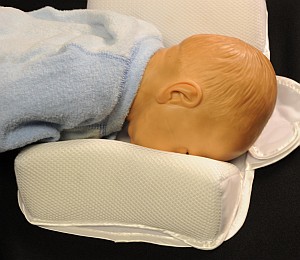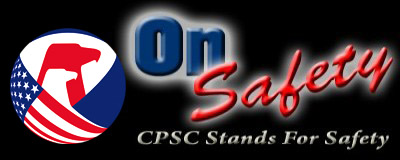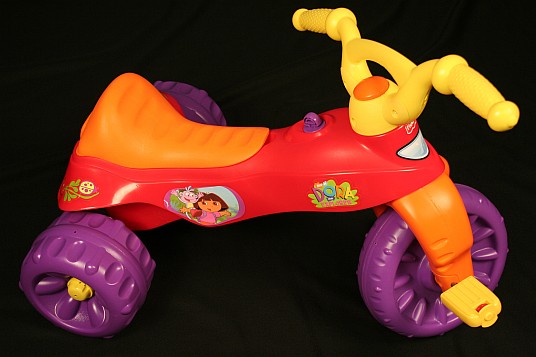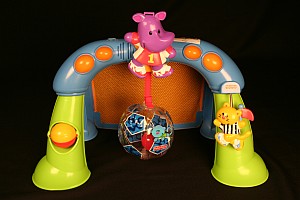CPSC and the U.S. Food and Drug Administration (FDA) are warning parents and caregivers to stop using sleep positioners. Over the past 13 years CPSC and FDA have received 12 reports of infants between the ages of 1 month and 4 months who have died when they suffocated in these positioners or when they became trapped between a sleep positioner and the side of a crib or bassinet. CPSC has received dozens of reports of infants who were placed on their backs or sides in sleep positioners, only to be found later in potentially hazardous positions within or next to the sleep positioners.
The safest crib is one with only a mattress and a tight-fitting sheet. Parents should stop using sleep positioners or ANY device to hold an infant on his or her back or side for sleep. These are unnecessary and can pose a suffocation risk to your baby.
For the safest sleep environment possible, place babies on their backs. Don’t put babies to sleep on top of pillows, comforters or thick quilts. And don’t place these items, or large stuffed toys, in your baby’s crib, bassinet or play yard.
An announcement such as this one is sure to raise some questions. Here are some answers.
What is a sleep positioner?
A sleep positioner is a product that is used to keep babies on their backs while sleeping. Some are flat mats with side bolsters, and others are inclined (wedge) mats with side bolsters. Both types of sleep positioners claim to help reduce the risk of Sudden Infant Death Syndrome (SIDS) by keeping babies on their backs, help with food digestion and reflux, ease colic, and prevent flat head syndrome.
Are the medical claims associated with these products true?
The FDA and CPSC staffs have stated that there is currently no scientific evidence supporting these medical claims. The American Academy of Pediatrics (AAP) already tells parents to avoid “commercial devices marketed to reduce the risk of SIDS.”
How are sleep positioners dangerous?

A baby's face can get trapped against the bolster of a sleep positioner causing the baby to suffocate.
Both types of sleep positioners present problems. If children are placed on their sides or stomachs on a flat sleep positioner, the babies’ faces can get trapped against the bolster causing babies to suffocate. Babies placed on their sides with the bolster at their backs can easily roll onto their stomachs with their faces pressed into the product, blocking their breathing.
Babies placed on inclined sleep positioners can scoot around and end up with their heads hanging over the high edge of the positioners. This can cut off babies’ ability to breathe. In addition, babies can easily roll from their sides to stomachs or scoot themselves downward with their faces pressed against a bolster in these positioners. If bolsters come loose, babies can become trapped between the sleep positioner and the side of a crib or bassinet.
In some inclined sleep positioners, babies have flipped off the positioner, ending up with the positioner landing on top of them. Each of these scenarios puts babies at risk of suffocation.
How do I make sure my baby stays on his back while sleeping?
Simply place your baby on his or her back in the crib. Once your baby rolls over onto his or her tummy, it’s okay to leave your baby there. Babies who can flip over can also turn their heads, a key developmental milestone that reduces the risk of suffocation. If your baby flips over while in a sleep positioner, however, he or she can have a hard time freeing his or her face from the device.
My baby has reflux and my sleep positioner helps. Do I really need to stop using it?
Yes, you should stop using these devices. FDA has no scientific proof that infant sleep positioners help to prevent gastroesophageal reflux disease (GERD). Talk with your pediatrician about safe sleep alternatives for your baby.
12 deaths in 13 years? Is this really a serious hazard?
The potential risk of suffocation and death is serious and preventable. CPSC and FDA believe there is no reason to introduce a risk into your baby’s crib, especially given the fact that there are no scientifically proven benefits of using sleep positioners.
Usually, you recall products that are unsafe. Why aren’t you recalling specific sleep positioners?
Because of the medical claims made with sleep positioners, they fall primarily under FDA’s jurisdiction, rather than CPSC’s. FDA is telling manufacturers of sleep positioners to submit scientific data to support their medical claims. Any manufacturer who makes a medical claim about a sleep positioner and who has not received FDA clearance must immediately stop marketing their products. Such devices are illegal and subject to FDA regulatory action.
If you have other questions, e-mail them to feedback@cpsc.gov.
This address for this post is: http://www.cpsc.gov/onsafety/2010/09/sleep-positioners-a-suffocation-risk/












